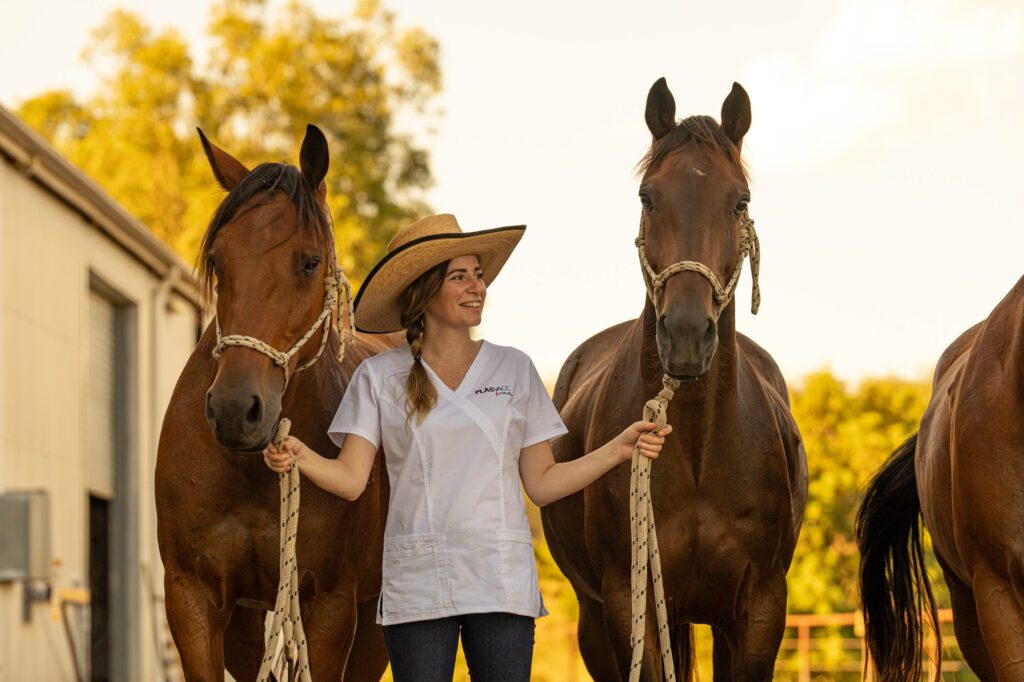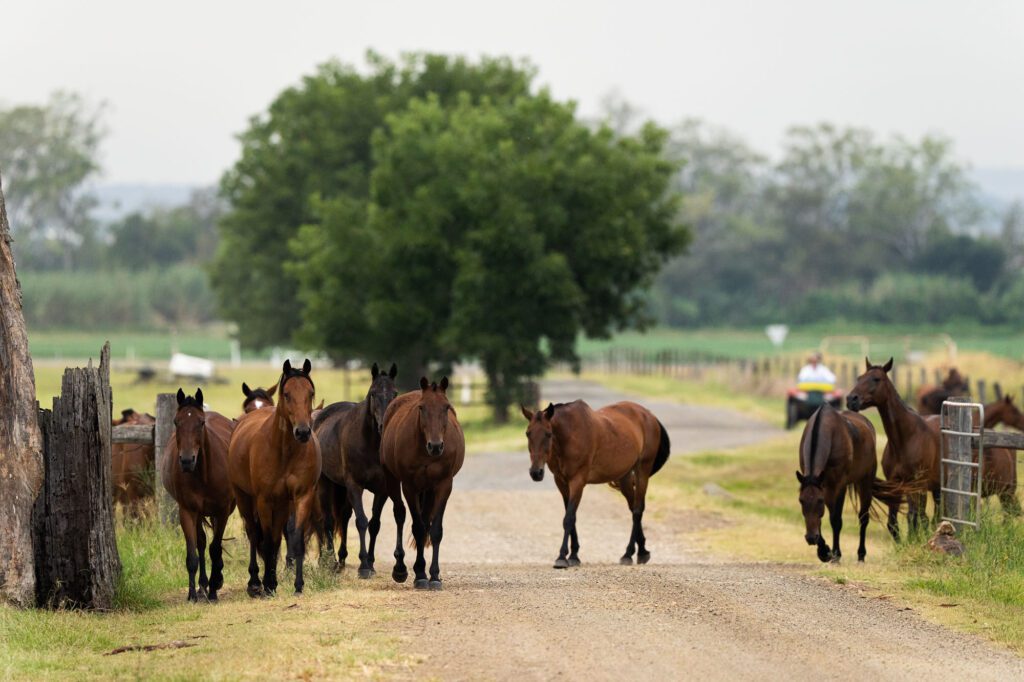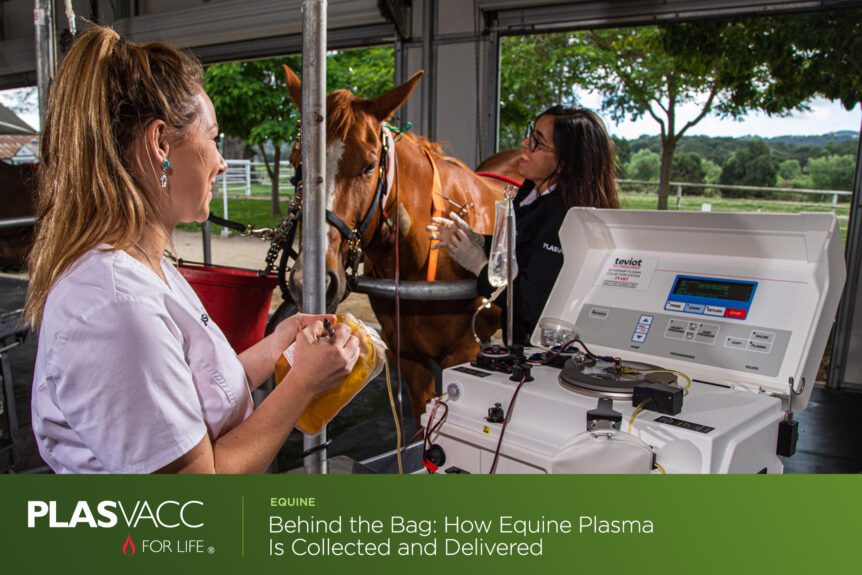Veterinarians know the value of plasma in critical cases. A single bag can mean the difference between a foal thriving or succumbing to infection. What’s not widely known is what goes on behind the scenes: the donor animals, the collection process, and the people dedicated to making sure every unit that leaves Plasvacc is safe, effective, and ethically sourced.
Horses with a New Purpose
A plasma donor horse isn’t just any horse pulled from a paddock. As the Plasvacc team explains, the starting point is good behaviour. “A great donor horse starts with a calm and level head. While each horse receives individual training to become a plasma donor, a calm nature determines whether a horse will be a great donor or not. Our horses must also be patient and respectful. They are handled by both experienced and inexperienced personnel on a regular basis with the safety of our staff being a top priority. Whilst any breed, size and colour can become a plasma donor, we love our Standardbreds here at Plasvacc! They are a nice size, often come well handled from their previous harness racing life and are some of the most gentle and calm horses,” says Production Manager, Rachel Brook.
Beyond health, personality matters. These horses are handled often, so they must be calm to catch, patient in a cross-tie, and safe for staff, farriers, and veterinarians. Many come to the program after retiring from other work, gaining a new life and a fresh purpose. You can read more about the donor herd here.
A Day in the Pasture
You might imagine the facility as clinical, but the reality is more pastoral. Donor horses only donate plasma about once a month. The rest of the time, they graze, roam, and socialise in large, irrigated paddocks.
As Production Manager Rachel Brook explains, “We aim to provide our horses with a natural environment where possible. Our horses live in large herds and often form little friendship circles within the herd. It’s often the weekly gossip here among the staff about who’s hanging out with who. Social aspects aside, the horses live out on improved pastures whilst also having access to trees, dams, back rubs as well as the odd encounter with the camels or dogs that also live here. When coming in to donate they are treated to a delicious ration or some molasses to keep them occupied. Most also use this time to have a good nap!”
She adds that new staff are often surprised by how relaxed the herd is. “I think it surprises everyone when they start just how happy, relaxed and quiet the horses are. Many haven’t worked with Standardbreds before, and they quickly become a favourite breed among the staff. These horses are given a new purpose in life here and are vital to the veterinary industry, and that gives the staff a great sense of pride in working with them.”


The Collection Process
When it comes time for donation, the procedure mirrors human plasma collection. Using advanced pheresing equipment in a closed system, whole blood is drawn, the plasma separated, and red cells returned to the donor. This method, as detailed on the Plasvacc Collection Process page, keeps donors comfortable while maximising safety.
There are eight carefully monitored steps: donor preparation, blood sampling, analysis and testing, centrifugal separation, plasma collection, return of cells, freezing and storage, and finally, distribution. Each bag is single-source and cell-free, never blended, which means traceability is absolute and the risk of reactions is reduced.
From a technical perspective, purity is everything. Protein levels are tracked during the procedure, sterility testing is performed on every batch, and immunoglobulin concentrations are confirmed in Plasvacc’s own laboratory. Plasma is frozen immediately and stored between –17°C and –40°C until shipped. You can find more about these stringent measures on the Purity and Safety page.
Safety That Rivals Human Standards
It’s easy to forget that veterinary plasma is held to many of the same standards as human products. Plasvacc is registered with the APVMA and NZFSA, and the same closed-system technology used for human collection is employed here. Anticoagulant sodium citrate is the only additive. No preservatives, no pasteurisation, nothing that dilutes the natural efficacy.
For clinics, this means confidence. When a unit of plasma is delivered, it has passed every test—sterility, antibody levels, purity, and safety—long before it leaves the facility.
What Surprises New Staff?
According to Rachel Brook, it’s not the science that surprises new team members most—it’s the bonds. “All of our techs who work quite closely with our horses have formed special bonds over the years! One of our techs, Liza, even adopted her favourite horse when she retired from plasma donation. We also have quite a few characters amongst the herd. Milo, the cheeky fellow, has opening gates down pat and if he’s not letting the whole herd into places they shouldn’t be, he’s up raiding the feed bins in the collection shed!”
For many staff, the reward lies not just in producing life-saving plasma, but in giving horses a new role, a safe environment, and meaningful daily care.
From Paddock to Patient
By the time plasma reaches a veterinary practice, it’s already been through a long journey: from the careful selection of donor horses to the precision of collection and the scrutiny of testing, all under the watchful eyes of those who care for the herd every day.
The result? Each bag is not just a treatment, but a story of science, compassion, and teamwork. For more details, you can visit the FAQ page or speak with the Plasvacc team about product availability and protocols.
Closing Thought
Plasma is often thought of as a product, but perhaps it’s better seen as a promise. Behind every bag is a herd of well-cared-for horses, a team of skilled technicians, and a system built on safety and trust. When veterinarians administer plasma, they’re drawing on that entire chain of care.

